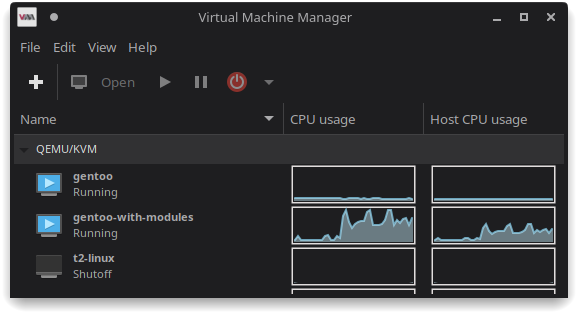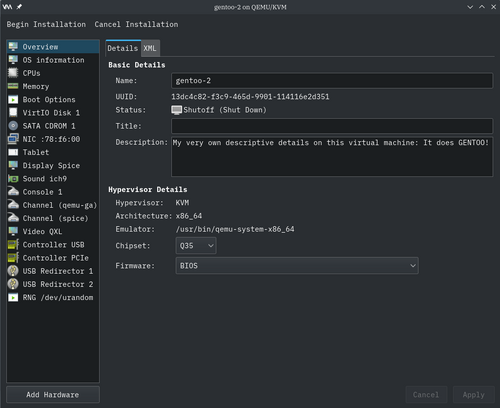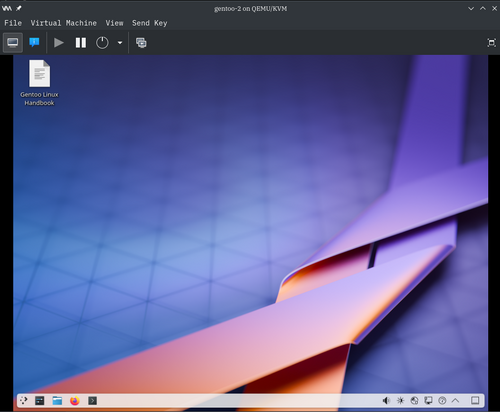virt-manager
virt-manager is a lightweight GUI application designed for managing virtual machines and containers via the libvirt API.
It provides a comprehensive view of all domains (VMs and containers), displaying their current state (running or inactive), along with real-time performance data and resource utilization stats. Users can easily create and configure new domains, storage, and network interfaces, while also reallocating host resources between guest domains as needed.
Primarily tailored for managing KVM-based VMs, virt-manager also supports Xen and LXC containers. The interface presents an overview of live domain performance, as well as resource allocation metrics.
Domain creation and configuration are streamlined with intuitive wizards, allowing for fine-grained control over resource allocation and virtual hardware settings.
For hands-on management, virt-manager includes an embedded VNC and SPICE client, providing full graphical console access to guest domains.
Overview
- First, virt-manager is a front-end to QEMU.
- virt-manager can create/delete/maintain an instance of many virtual machine (VM).
- virt-manager can start/stop a VM or a container.
- virt-manager can mount a CD-ROM ISO image.
- virt-manager can create different networking connections for the guest OS in VM to use.
- virt-manager can create bridges, MACVLAN, static netdev, and NAT'd IP interface.
- virt-manager can create/delete/maintain storage pools using many different filesystems such as directory, direct hard drive, gluster, iSCSI, LVM, multi-path devices, NetFS, SCSI, RADOS/Ceph, and Sheepdog.
virt-manager is a Python3 front-end script to both libvirt and QEMU main binary. Works on KDE and Gnome equally; also leverages gnome-keyring and kwalletcli for proper password storages.
The virt-manager main window looks like:
The domain window in detail mode looks like:
In console mode, the domain window looks like:
VM scopes
Each VM is a domain, when working with libvirt library and libvirt-client applications (ie., virsh, virt-manager).
It is a domain instead of virtual machine (VM) because virt-manager/virsh/Libvirt refers to a container (LXC, Docker, Podman) or a virtual machine (QEMU, KVM, Xen, VirtualBox) depending on the environment, as well as its network profile, disk layouts, and available bare-metal resources: a domain.
Each domain can be in one of two different process ownerships and one of two different machine placements:
The process ownership available for a running domain are:
- Session mode, User - Non-zero user ID
- System mode, System daemon - root, UID=0
The machine placements are:
- on a local host machine, on-premise
- in a remote host machine, separated by network
Libvirt terminology: The machine running libvirtd is a local host or a local hypervisor.
The local hypervisor running inside another local hypervisor is a nested hypervisor. The domain running inside a local but nested hypervisor is the nested guest domain.
Privileges
Domain can run as the root or as the user's group ID matching the libvirt group name (or the wheel if no policykit package installed).
For a system-mode domain, the title bar of its detailed or console window does NOT show a "User session" phrase following its domain name and virtualization engine (QEMU/KVM) type.
For a session-mode domain, the title bar of its detailed or console window does show a "User session" after the domain name and virtualization engine (QEMU/KVM) type.
System mode
Domain can run in privileged (root) mode as a system daemon.
System domain is started after the init system initialization of host startup single-user/storage/network stages.
To run in system mode:
host$virt-manager --connect=qemu:///system Session mode
A domain that runs in user-mode is a "User session" or a session mode.
To start a session-mode domain, a user must be given the libvirt group privilege (see also permissions in Libvirt).
Session-mode domain are started from the user-mode or from the display manager AutoStart script upon user login and after starting X/Wayland.
Session-mode domain runs in an unprivileged mode (not as root). If a user does not have the libvirt group in its supplementary group list, then use sudo start in root:
user $sudo virt-manager --connect qemu:///sessionUser with the libvirt group can start a domain in either system-mode or session-mode.
Machine placements
Each domain can run on an on-premise (local host, or sometimes a bare-metal) or can run in a cloud (remote host).
To run a domain, a hypervisor controller (libvirtd) must be up and running on a host machine, local or remote.
A local host may be on a local physical server (on-premise) or inside another local hypervisor (guest host).
libvirtd must have their control socket opened before the virt-manager/virsh can manage the domain(s) on a host.
Control socket of a libvirtd are accessible by an UNIX domain socket (/var/run/libvirt/libvirt-sock) or by a inet socket (only for remote host) over TCP/IPv4 or TCP/IPv6 protocol.
Local domain placement
A hypervisor controller running on a local host controls the local domain.
To control the domain on a local host:
host$virt-manager --connect qemu:///sessionRemote domain placement
The remote host system (aka cloud-based) are accessible by libvirt-based client (virt-manager, virsh).
To access the remote hypervisor controller by a TCP port number (default is 16509/tcp):
host$virt-manager --connect qemu+tcp://remote-host/system
Remote domain placement, by port #
To access the remote hypervisor controller by a non-default port number:
host$virt-manager --connect qemu+tcp://remote-host:<port>/systemTo access securely the remote hypervisor controller using SSH protocol over tcp/22 port:
host$virt-manager --connect qemu+ssh://remote-host:<port>/systemInstallation
BIOS/UEFI
Verify that the host hardware has the needed virtualization support, issue the following command:
host-root#grep --color -E "vmx|svm" /proc/cpuinfoThe vmx or svm CPU flag should be red highlighted and available.
And file /dev/kvm must exist as well:
host-root#ls /dev/kvm/dev/kvm
If /dev/kvm does not exist, go back to QEMU for compliance.
USE flags
USE flags for app-emulation/virt-manager Desktop tool for managing libvirt virtual machines
gui
|
Enable support for a graphical user interface |
policykit
|
Enable PolicyKit (polkit) authentication support |
sasl
|
Enable connecting to SASL-enabled (e.g. Kerberos-protected) instances |
verify-sig
|
Verify upstream signatures on distfiles |
If virt-manager is going to be used, be sure to enable the
usbredir and spice USE flags on the qemu package for correct operation.
Emerge
root #emerge --ask app-emulation/virt-manager
Additional software
The virt-manager requires the app-emulation/libvirt package. See Libvirt — a virtualization management toolkit for installation.
Configuration
Environment variables
A list of optional environment variables that are read and checked by the virt-manager command:
| Environment variable name | Description |
|---|---|
| HOME | path of home directory. |
| DISPLAY | the display X server and screen to which graphical applications should be sent. |
| WAYLAND_DISPLAY | the display Wayland server and screen to which graphical applications should be sent. |
| LANG | the default system locale and language settings. |
| LANGUAGE | the user's preferred language(s) for software localization, overriding the default language defined by $LANG |
| GSETTINGS_BACKEND | which backend is used for the GSettings system, which is part of the GNOME configuration system. Valid values are dconf and memory. |
| GSETTINGS_SCHEMA_DIR | the directory where GSettings schemas are located. |
| SSH_ASKPASS_REQUIRE | controls whether SSH uses an external program to prompt for a password when accessing a remote system. When set to yes, SSH will require a password prompt and will use the SSH_ASKPASS program to request the password. When set to no, it disables the password prompt, allowing for key-based authentication or other non-interactive methods.
Example: SSH_ASKPASS_REQUIRE=yes ensures that an SSH password prompt will be shown when needed. |
Environment variables - Test
- VIRTINST_TEST_SUITE
- VIRTINST_TEST_SUITE_FORCE_LIBOSINFO
- VIRT_MANAGER_DEFAULT_FORK
Files
Whenever a domain starts, virt-manager checks for that domain XML file in each of the following paths:
- System mode: /etc/libvirt/qemu/
- User mode: $HOME/.config/libvirt/qemu/
The virt-manager command uses the following files:
| Environment variable name | Description |
|---|---|
| HOME | path of home directory. |
| DISPLAY | the display X server and screen to which graphical applications should be sent. |
| $HOME/.config/libvirt/qemu/ | Domain configs (user session) |
| $HOME/.config/libvirt/qemu/ | Domain configs (user session) |
| /var/lib/libvirt/images/ | Default VM disk image storage |
| /run/libvirt/ or /var/run/libvirt/ | Runtime data (sockets, PIDs, state) |
| /usr/share/OVMF/, /usr/share/qemu/ | Firmware for booting VMs |
| /etc/libvirt/qemu/networks/ | Virtual network configs |
| /var/lib/libvirt/dnsmasq/ | DHCP leases, runtime network info |
| /etc/libvirt/storage/ | Storage pool metadata |
| etc/apparmor.d/ or /etc/selinux/ | Security profiles (optional) |
| /var/run/libvirt/libvirt-sock | Control channel to hypervisor controller on local host |
| $HOME/.cache/virt-manager/virt-manager.log | Log file for user sessions |
| /proc/sys/kernel/cap_last_cap | |
| /sys/devices/system/cpu/possible | |
| /sys/devices/system/node/node0/meminfo | |
| /sys/devices/system/node | |
| $HOME/.cache/gstreamer-1.0/registry.x86_64.bin | |
| $HOME/.config/dconf/user | |
| $HOME/.config/gtk-3.0/colors.css | |
| $HOME/.config/gtk-3.0/gtk.css | |
| $HOME/.config/gtk-3.0/settings.ini | |
| $HOME/.config/gtk-3.0/window_decorations.css | |
| $HOME/.config/user-dirs.dirs | |
| $HOME/.local/share/mime//mime.cache | |
| /etc/libvirt/qemu/ | Domain XML configs (system) |
User permissions
To gain privilege in using virt-manager in user session mode, check for the libvirt group in user's supplementary group list:
host$iduid=1000(jdoe) gid=1000(jdoe) groups=1000(jdoe),24(cdrom),25(floppy),27(sudo),29(audio),30(dip),44(video),46(plugdev),100(users),102(input),104(kvm),106(netdev),111(bluetooth),113(lpadmin),117(scanner),130(libvirt),131(wireshark),132(pipewire),993(ssh)
If libvirt is in the supplementary group, then virt-manager is ready for session (non-root) usage. Skip this subsection.
If libvirt is missing, complete the Group permission setup for Libvirt.
Autostart
Autostarting a domain can be done in session-mode or system-mode.
System-mode autostart
AutoStart for system-mode domain is natively supported by libvirtd.
For AutoStart option of a domain on power-up/reset:
- from the virt-manager "
Virtual Machine Manager" window, select the domain in the main panel, go to Edit->Virtual Machine Details menu suboptions, - or from the virt-manager "
<domain> on QEMU/KVM" window, go to View->Detail menu options then select Boot Options line item in left navigation panel: under Autostart in main panel
Toggle the checkbox for "Start virtual machine at boot up".
Session-mode autostart
The hypervisor controller (libvirtd) does not support directly the autostart of session-mode --connect=qemu:///session) domains.
Because session mode runs as the unprivileged user, its libvirt instance is only available after a user logs in.
Also, libvirtd does not handle session mode.
The choices of auto-starting a session-mode domain are:
- XDG AutoStart mechanism
- Login script
- X session script
XDG AutoStart mechanisms
Create a .desktop-type file in $HOME/.config/autostart/ directory.
host$vi $HOME/.config/autostart/libvirt-mydomain.desktopReplace mydomain with the actual domain name.
Fill the .desktop file with:
$HOME/.config/autostart/libvirt-mydomain.desktop"Typical .desktop file"[Desktop Entry]
Name=My Domain VM
Type=Application
Exec=virsh --connect qemu:///session start mydomain
X-GNOME-Autostart-enabled=true
Replace mydomain with the actual domain name.
KDE Plasma will autostart ANY file in $HOME/.config/autostart/ directory, so no additional configuration setting is needed for KDE Plasma
For advance control of starting session-mode domains under KDE Plasma, select one of the following lines for your .desktop file:
$HOME/.config/autostart/libvirt-mydomain.desktop.desktop file contentX-KDE-autostart-phase=0 # Pre-KDE startup
X-KDE-autostart-phase=1 # After KDE startup
X-KDE-autostart-phase=2 # After user apps
UNIX script
To autostart by UNIX login script, use one of the following login scripts:
- $HOME/.bash_profile
- $HOME/.profile.d/libvirt-autostart.sh
And insert the following command line into that login script:
virsh --connect qemu:///session start <vm-name>
Usage
The virt-manager can start domains in either system (root) or session (user) mode. For persistent domain operation, use system mode. For desktop session only (it goes away at logout), use session mode.
Use --connect=qemu:///system if domain should start at bootup without any user desktop login. Use --connect=qemu:///session if only for the duration of a user's desktop session. Autostart option is available for both
For the session mode, run:
host$virt-manager
For the system-mode, add the --connect=qemu:///system option to virt-manager command.
host-platform$virt-manager --connect=qemu:///systemConnect types
virt-manager can connect to multiple local hosts and remote hosts using different protocols.
The types of connections to a hypervisor controller are:
- qemu:// - local host UNIX domain socket to QEMU.
- xen:// - local host Xen Domain 0 (Dom0)
- qemu+ssh:// - a secured connection to QEMU over SSH/TCP protocol
- xen+ssh:// - a secured connection to Xen Dom0 over SSH/TCP protocol
See URI in Libvirt for more breakdown details of Connect Type URI.
Starting
To start virt-manager:
host$virt-managerTo start virt-manager with the configuration window to gentoo guest host, using default QEMU UNIX socket connection:
host$virt-manager --connect qemu:///system --show-domain-editor gentooLibvirt terminology: The domain running inside a local hypervisor is a guest host.
Starting domain
Domain can be started in:
- virt-manager domain window, by clicking on Power On icon button with tip "Power on the virtual machine"
- virt-manager domain window, by Virtual Machine->Run menu option
- virt-manager main window, by selecting the domain in main panel under "QEMU/KVM User Session" group, then right-mouse context menu, then Run
- by AutoStart init script executed by the display manager upon user login.
Starting a display manager implies that system init initialization of local host single-user/storage/network stages are completed beforehand.
Shutting down
- From the host platform:
- In virt-manager main menu bar using Virtual Machine -> Shutdown
- From within the guest host:
- From the window manager, Start -> Shutdown icon
Invocation
user $virt-manager --helpusage: virt-manager [options]
optional arguments:
-h, --help show this help message and exit
--version show program's version number and exit
-c URI, --connect URI
Connect to hypervisor at URI
--debug Print debug output to stdout (implies --no-fork)
--no-fork Don't fork into background on startup
--show-domain-creator
Show 'New VM' wizard
--show-domain-editor NAME|ID|UUID
Show domain details window
--show-domain-performance NAME|ID|UUID
Show domain performance window
--show-domain-console NAME|ID|UUID
Show domain graphical console window
--show-domain-delete NAME|ID|UUID
Show domain delete window
--show-host-summary Show connection details window
Also accepts standard GTK arguments like --g-fatal-warnings
Troubleshooting
virt-manager gui doesn't start or "virt-manager: command not found"
Version 4.1.0 changed USE flags, switching from gtk flag to gui. In order to (re)enable gui, the user must enable the gui flag before (re)build the package.
host-root#echo "app-emulation/virt-manager gui" >> /etc/portage/package.use/app-emulationno polkit agent available to authenticate action 'org.libvirt.unix.manage'
This usually results from the user not being in the libvirt group. Add the user to the group with:
host-root#usermod -aG libvirt larryQEMU/KVM not connected
Virt-manager uses libvirt as its backend to manage virtual machines. Therefore, the libvirt daemon needs to be started.
host-root#libvirtdOr to start libvirtd at startup, add the daemon to the OpenRC runlevel / systemd target:
In OpenRC boot environment:
host-root#rc-update add libvirtd defaultIn SystemD boot environment:
host-root#systemctl enable libvirtd'NoneType' object has no attribute 'conn'
This is typically a result in the cursor settings being misconfigured. The simplest fix is installing x11-themes/adwaita-icon-theme and updating gsettings to use the Adwaita cursor theme.
root #emerge --ask x11-themes/adwaita-icon-themehost$gsettings set org.gnome.desktop.interface cursor-theme "Adwaita"Removal
root #emerge --ask --depclean --verbose app-emulation/virt-managerSee also
- Virtualization — the concept and technique that permits running software in an environment separate from a computer operating system.
- QEMU — a generic, open-source hardware emulator and virtualization suite.
- QEMU/Front-ends — facilitate VM management and use
- Libvirt — a virtualization management toolkit
- Libvirt/QEMU_networking — details the setup of Gentoo networking by Libvirt for use by guest containers and QEMU-based virtual machines.
- Libvirt/QEMU_guest — creation of a guest domain (virtual machine, VM), running inside a QEMU hypervisor, using tools found in libvirt package.
- Virt-manager/QEMU_guest — creation of a guest virtual machine (VM) running inside a QEMU hypervisor using just the virt-manager GUI tool.
- QEMU/Linux guest — describes the setup of a Gentoo Linux guest in QEMU using Gentoo bootable media.
- GPU passthrough with virt-manager, QEMU, and KVM — directly present an internal PCI GPU as-is for direct use by a virtual machine
- Virsh — a CLI-based virtualization management toolkit.



